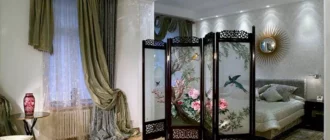
Arabic style in the interior – spectacular luxury and stunning comfort of oriental life
The Arabic style is based on strict Islamic canons and centuries-old oriental traditions, it clearly reflects the way of life of the nomadic peoples of North Africa and a large part of the Asian continent.
Arabic style today is popular not only in its historical homeland. This majestic and mysterious direction of interior design is also in demand in Western Europe, the USA and Canada among lovers of luxury and comfort, respectable families with great wealth and cozy oriental restaurants.

Features
Arabic style in the interior can be easily recognized by its numerous distinctive features. Among them, it is worth noting:
- The complete absence of picturesque paintings and sculptural compositions in the setting. This is due to the prohibition in Islam on the use of any images of people and wildlife.
- The abundance of ornate patterns, oriental ornaments and geometric patterns in the design of the premises. Intricate paintings cover large surfaces of walls and ceilings.
- The predominance of bright saturated colors and combinations of warm colors. Preference is given to red, orange, yellow and brown colors.
- Lack of traditional European interior doors. Thick curtains are commonly used to drape arched doorways.
- Rich room lighting. For these purposes, not only huge wrought iron chandeliers are used, but also many small wall sconces, floor lamps and table lamps.
- Original furniture options. Instead of the usual tables, armchairs and chairs, the atmosphere of the room is filled with low soft sofas, pillows, and ottomans.
- Lots of oriental decor. In addition to the characteristic Arabic vases and jugs, decorative silver or bronze metal utensils, cold weapons, forged candlesticks, pillows and caskets are great for creating a sophisticated atmosphere in the room.
- The ideal solution for an Arabic-style floor is considered to be the placement of a large handmade carpet with oriental ornaments in the room. In addition, not only the floor, but also the walls are often decorated with carpets to emphasize the adherence of the owners to the ancient oriental traditions.
- A huge role in the Arabic style of the interior is played by mosaics. Ornaments made of small pieces of ceramics adorn not only walls, floors, columns and arches, but also the surfaces of furniture. In window openings, instead of ordinary glass, original multi-colored stained-glass windows are often installed.


The history of the Arabic style in the interior
The Arabic style was formed over many centuries and for many years was carefully guarded from the eyes of Christians. Only a few European travelers had the opportunity to see with their own eyes the luxury of the interior decoration of the palaces of the sultans and viziers. Until the beginning of the 18th century, the Arabic style in the interior was common only in the countries of the Middle East and North Africa.
But with the beginning of the active penetration of Europeans into these territories, the situation began to change. Upon returning to their homeland, many successful colonialists brought with them items of Arabic decor and tried to recreate a luxurious oriental interior at home.


Gradually, the Arabic style gained popularity in Europe, especially among the wealthy bourgeoisie in big cities. The fashionable oriental design direction could not compete on equal terms with traditional European interior styles, but it always had its adherents.
In the second half of the 20th century, many conservative Arab countries began to pursue a more open policy towards foreigners. Large-scale development of huge reserves of Middle Eastern oil has led to a rapid improvement in the living standards of local residents.

Massive construction of comfortable hotels in oriental style has begun in the United Arab Emirates, Saudi Arabia, Kuwait and other countries of the region. The Arabic interior style has become not only a popular design trend, but also an obvious standard of luxury. And many VIPs, show business stars and major politicians of world importance can be safely attributed to the number of his adherents.














